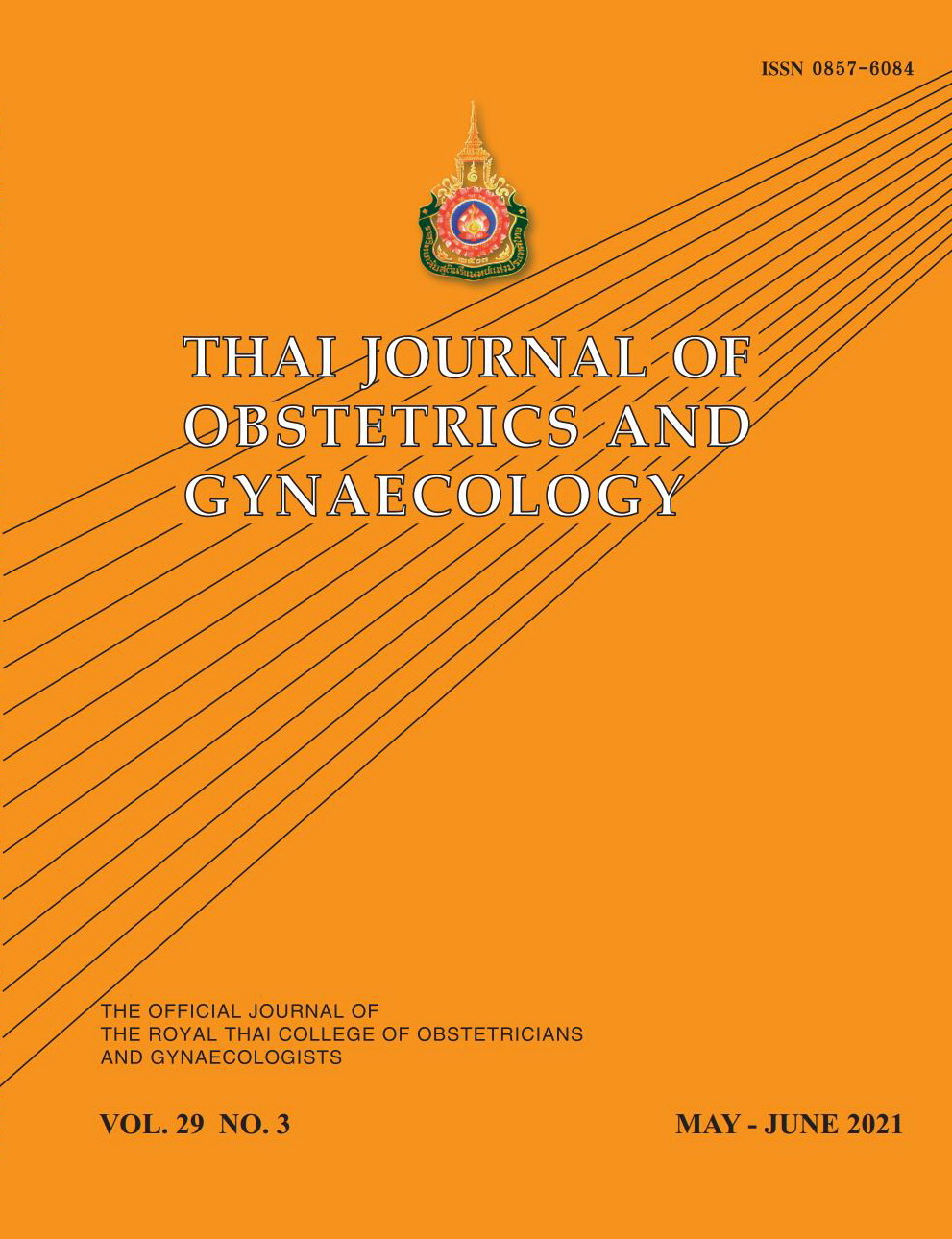Waist Circumference at 18 weeks of Gestation as a Predictor for Gestational Diabetes Mellitus in Women with Normal Pre-pregnancy Body Mass Index
Main Article Content
Abstract
Objectives: This work aimed to investigate the predictability of waist circumference (WC) for gestational diabetes mellitus (GDM) in women with normal pre-pregnancy body mass index (BMI).
Materials and Methods: A total of 230 pregnant women with normal pre-pregnancy BMI were enrolled. WC was measured at 18 weeks of gestation. The women were divided into two groups: WC < 80 and ≥ 80 cm. Each group was provided with information about the risk factors for GDM. All women had a blood sample taken for the 50-grams glucose challenge test (GCT) at 24-28 weeks of gestation. If a sample was abnormal, it was followed by the 100-grams oral glucose tolerance test (OGTT).
Results: Women in the WC ≥ 80 cm group were significantly older in age, multiparous, and had a higher BMI and percentage distribution for GDM. Women with WC ≥ 80 cm tended to have an increased risk for GDM (Odds ratio (OR) 3.71, 95% confidence interval (CI) 1.31-10.53, p = 0.014). However, after multivariate regression, adjustment by advanced maternal age (AMA), first degree relative with diabetes, history of giving birth to fetal anomaly, weight gain, pre-pregnancy BMI and multiparous found no statistical significance (OR 3.50, 95%CI 0.93-13.20, p = 0.064). WC ≥ 82 cm was the new termination point with higher sensitivity, specificity, and positive and negative predictive values.
Conclusion: WC ≥ 80 cm was found to increase the risk for predicting GDM in univariate analysis. After multivariate analysis, WC ≥ 80 cm tended to increase risk, through there was no statistical significance. Future studies with large population should be performed.
Article Details

This work is licensed under a Creative Commons Attribution-NonCommercial-NoDerivatives 4.0 International License.
References
Cunningham FG, Leveno KJ, Bloom SL, Dashe JS, Hoffman BL, Casey BM, et al. Williams Obstetrics. 25th ed. New York: McGraw Hill 2018:1107-14.
Nguyen CL, Pham NM, Binns CW, Duong DV, Lee AH. Prevalence of gestational diabetes mellitus is eastern and southeastern asia: A systemic review and meta-analysis. J Diabetes Res 2018:1-10.
Sananpanichkul P. Diagnosis of gestation diabetes mellitus by 50 grams glucose challenge test. J Prapokklao Hosp Clin Med Educat Center 2012;29:14-23.
American College of Obstetricians and Gynecologists. Gestational diabetes mellitus. Practice bulletin No. 190. Obstet Gynecol 2018;131:e49-e64.
The international diabetes federation. The IDF consensus worldwide definition of the metabolic syndrome. Belgium: IDF communication 2006.
Aekplakorn W, Kessomboon P, Santhong R, Chariyalertsak S, Putwatana P, Inthawong R, et al. Urban and rural variation in clustering of metabolic syndrome components in the Thai population : results from fourth National Health Examination Survey 2009. BMC Public Healths 2011;11:854.
Ebrahimi-Mameghani M, Mehrabi E, Kamalifard M, Yavarikia P.Correlation between body mass index and central adiposity with pregnancy complications in pregnant women. Health Promot Perspect 2013;3:73-9.
Bolognani CV, de Sousa Moreira Reis LB, de Souza SS, Dias A, Cunha Rudge MV, de Mattos Paranhos Calderon I. Waist circumference in predicting gestational diabetes mellitus. J Matern Fetal Neonatal Med 2014;27:943-8.
Gao X, Yan Y, Xiang S, Zeng G, Liu S, Sha T, et al. The mutual effect of pre-pregnancy body mass index, waist circumference and gestational weight gain on obesity-related adverse pregnancy outcomes: A birth cohort study. PLoS One 2017;12:e0177418.
Han Q, Shao P, Leng J, Zhang C, Li W, Liu G, et al. Interactions between general and central obesity in predicting gestational diabetes mellitus in Chinese pregnant women: a prospective population-based study in Tianjin, China. J Diabetes 2018;10:59-67.
Kansu-Celik H, Karakaya BK, Tasci Y, Hancerliogullari N, Yaman S, Ozel S, et al. Relationship maternal subcutaneous adipose tissue thickness and development of gestational diabetes mellitus. Interv Med Appl Sci 2018;10:13-8.
He F, He H, Liu W, Lin J, Chen B, Lin Y, et al. Neck circumference might predict gestational diabetes mellitus in Han Chinese women: A nested case-control study. J Diabetes Investig 2017;8:168-73.
White SL, Lawlor DA, Briley AL, Godfrey KM, Nelson SM, Oteng-Ntim E, et al. Early antenatal prediction of gestational diabetes in obese women: development of prediction tools for targeted intervention. PLoS One 2016;11:0127846.
Tomedi LE, Simhan HN, Chang CC, McTigue KM, Bodnar LM. Gestational weight gain, early pregnancy maternal adiposity distribution, and maternal hyperglycemia. Matern Child Health 2014;18:1265-70.
Grieger JA, Bianco-Miotto T, Grzeskowiak LE, Leemaqz SY, Poston L, McCowan LM, et al. Metabolic syndrome in pregnancy and risk for adverse pregnancy outcomes: A prospective cohort of nulliparous women. PLoS Med 2018;15:e1002710.
Madhavan A, Beena Kumari R, Sanal MG.A pilot study on the usefulness of body mass index and waist hip ratio as a predictive tool for gestational diabetes in Asian Indians. Gynecol Endocrinol 2008;24:12:701-7.
World Health Organization.Waist circumference and waist–hip ratio: report of a WHO expert consultation. Geneva: WHO 2011.


